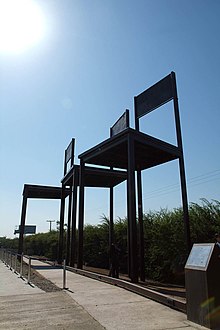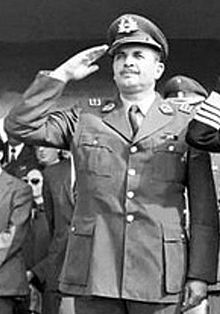César Mendoza
César Leonidas Mendoza Durán (born September 11, 1918 in Santiago de Chile ; † September 13, 1996 ibid) was a Chilean show jumper and general who won the silver medal with the team in jumping at the 1952 Summer Olympics in Helsinki . After the military coup of September 11, 1973, he became Director General of the National Police (Carabineros de Chile) and was as such a member of the ruling military junta (Junta de Gobierno de Chile) until August 2, 1985 during the military dictatorship under General Augusto Pinochet .
Life
Career with the Carabineros and winner of the Olympic silver medal
After attending school, Mendoza began training at the National Police School (Escuela de Carabineros) , which he graduated as a corporal in 1940 . In the following years he found various uses and was promoted to lieutenant in 1942 .
In the early 1950s he was part of the Chilean show jumping team and was with them at the 1952 Summer Olympics in Helsinki. Together with Óscar Cristi on "Bambi" and Ricardo Echeverria on "Lindo Peal", he won the silver medal on "Pillán" with 45.75 points in the team competitions in show jumping after the team from Great Britain . He was one of the few Olympic medalists from Chile . In the individual competition, after a 21st place in the first and first place in the second round, he finished seventh in the final round.
After his return, Mendoza was promoted to captain in 1953 , major in 1959 and lieutenant colonel of the Carabineros in 1965 . He was later promoted to colonel in 1968 and general in 1970. As such, he became General Inspector of the Carabineros in 1972.
September 11th military coup, Commander in Chief of the Carabineros and member of the military junta
Afterwards he was director for welfare services of the armed forces and thus held the tenth rank within the Chilean military hierarchy. On September 10, 1973, he met with General Gustavo Leigh , the Commander of the Air Force (Fuerza Aérea) together, and accepted while the participation of Carabineros where for 11 September 1973 at 6am, provided military coup against President Salvador Allende .
On the night of September 10-11 , 1973, he and General Arturo Yovane Zúñiga went to the National Police NCO School (Escuela de suboficiales de Carabineros) , the only unit that did not want to take part in the coup. On the day of the coup itself, he and Yovane appeared at the Carabineros' intelligence center in order to control the combat operations of the National Police, which were not assigned a specific combat location. Shortly before his death in the La Moneda presidential palace, Allende referred to Mendoza as “the creeping general” ('el general rastrero').
After the successful military coup and Allende's death, Mendoza first appeared in the national public when he was appointed one of the first members of the ruling military junta (Junta de Gobierno de Chile) . At the same time, he took over the post of General Director of the Carabineros as the successor to General José María Sepúlveda Galindo . The national police were thus integrated into the military junta. Until then, the Carabineros were under the Ministry of the Interior as part of the public service and were not part of the armed forces.
The Caso Degollados , resignation as head of the Carabineros and last years of life

When José Manuel Parada Maluenda , Manuel Guerrero Ceballos and Santiago Nattino , three functionaries of the Partido Comunista de Chile , were kidnapped and murdered on March 30, 1985 , this act was initially presented as a settlement between communists . However, it was quickly suspected that the national police were responsible for this act, the so-called Caso Degollados . The investigation by examining magistrate José Cánovas Robles finally proved, through a review and analysis of data and documents from the CNI (Central Nacional de Informaciones) , that the police public relations department DICOMCAR (Dirección de Comunicaciones de Carabineros) was involved in the murder of the three Party officials was involved.
This made General Mendoza unsustainable for the office of Director General of the Carabineros and a member of the government junta. He finally resigned on August 2, 1985 from these offices and was replaced by General Rodolfo Emilio Eduardo Stange Oelckers . After retiring from active military service, he returned to equestrian sport and also became a member of the Supreme Council of the Universidad Las Condes, founded in 1987 .
In 1991, the former director general of the National Police was faced with another trial. This time it was a defamation case after the former communist MP María Adela Maluenda Campos , mother of the murdered José Manuel Parada Maluenda, gave an interview about the former general in a magazine.
In a further trial on March 26, 1992, he was charged by the future Supreme Court Justice, Milton Iván Juica Arancibia , with the criminal offense of aiding a terrorist conspiracy. However, on April 24, 1992, he was released after paying bail.
Mendoza, who died of a pancreatic tumor , was married with two children.
Web links
- Entry (No. 19) in 11 DE SEPTIEMBRE DE 1973: Golpe Militar en Chile
- Entry in memoriaviva.com
- Cuerpe de Generales de Carabineros - In Memoriam
Individual evidence
- ↑ Entry in sports-reference.com
- ↑ Leaders of Chile
- ↑ Iván Vargas Ljubetic: Chile: La historia de siniestra Carabineros de Chile (13 February 2013)
| personal data | |
|---|---|
| SURNAME | Mendoza, César |
| ALTERNATIVE NAMES | Mendoza Durán, César Leonidas |
| BRIEF DESCRIPTION | Chilean show jumper, general and politician |
| DATE OF BIRTH | September 11, 1918 |
| PLACE OF BIRTH | Santiago de Chile |
| DATE OF DEATH | September 13, 1996 |
| Place of death | Santiago de Chile |
